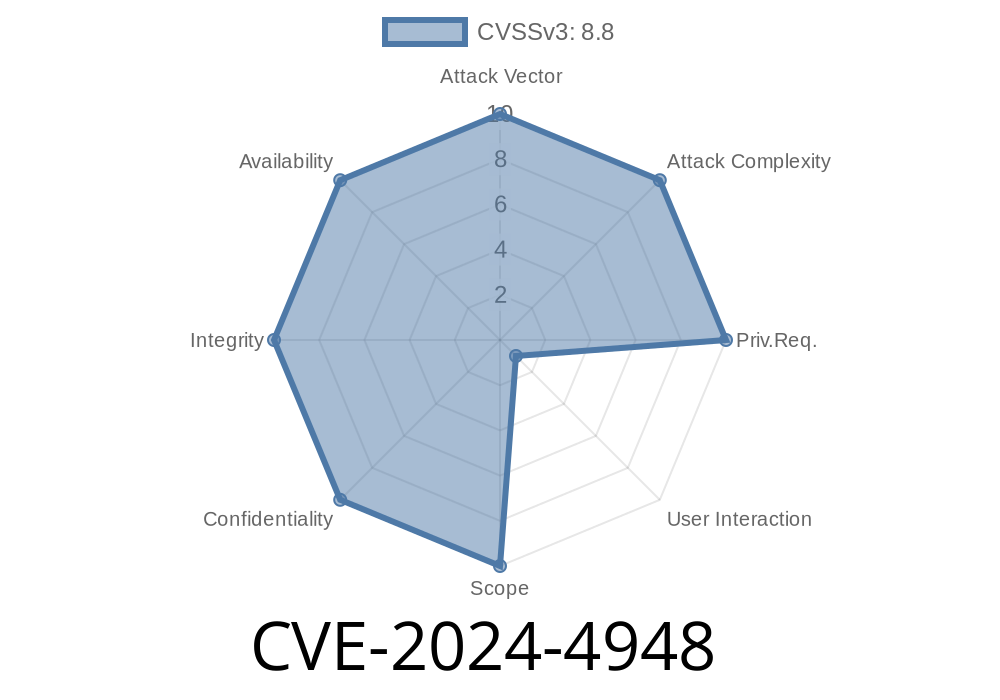---
Introduction
In this post, we'll dive into a recent discovery of a use-after-free vulnerability in Google Chrome's Dawn engine, specific to versions prior to 125..6422.60. This vulnerability, assigned the CVE number CVE-2024-4948, allows a remote attacker to potentially exploit heap corruption via a crafted HTML page. The Chromium security team has categorized this vulnerability as having a "High" severity level.
To provide some context, Dawn is a cutting-edge rendering engine used in Google Chrome that aims to harness the power of modern GPUs to deliver fast and efficient web graphics. However, as with any software, vulnerabilities can be discovered and exploited by malicious actors. In this case, the vulnerability occurs due to a use-after-free error within the Dawn engine.
We'll discuss the technical details of the vulnerability, show a code snippet illustrating the use-after-free error, and explain how an attacker might exploit this issue. Finally, we'll provide links to the original references and information on how to protect your Chrome installation from this vulnerability.
Code Snippet
A use-after-free vulnerability is a type of memory corruption bug that occurs when a program continues to use a pointer after the memory it points to has been freed. In the case of CVE-2024-4948, the vulnerability was discovered within a specific function in the Dawn engine.
Here's a simplified example of a code snippet illustrating the use-after-free error
class MyClass {
public:
int* data;
MyClass() {
data = new int[10];
}
~MyClass() {
delete[] data;
}
};
MyClass* object = new MyClass();
delete object;
int value = object->data[5]; // Use-after-free occurs here
In this example, the memory allocated for object is freed with delete object;. However, the program then proceeds to access the data member of object, which is no longer valid. This use-after-free error can lead to unpredictable behavior and potentially allow an attacker to corrupt the heap memory.
Exploit Details
To exploit the CVE-2024-4948 vulnerability, an attacker would need to create a specially crafted HTML page that triggers the use-after-free error in the Dawn engine. This crafted HTML page could then be served to a victim through a malicious website or embedded within an online advertisement, among other delivery methods.
Once the victim visits the malicious page using a vulnerable version of Chrome, the use-after-free error could be triggered, leading to heap corruption. Depending on the specific location of the memory corruption within the heap, an attacker could potentially execute arbitrary code on the victim's machine or cause the browser to crash, leading to a denial-of-service attack.
Original References
For more detailed information regarding the CVE-2024-4948 vulnerability, you can refer to the following original references:
1. The official Chromium advisory discussing the vulnerability: link
2. The Chromium source code with the fix for the vulnerability: link
3. The National Vulnerability Database (NVD) entry for CVE-2024-4948: link
Protecting Your Chrome Installation
To mitigate the risk associated with CVE-2024-4948, it's essential to keep your Google Chrome browser updated to the latest version. Google has released Chrome version 125..6422.60, which includes a fix for this vulnerability. To update your Chrome browser, follow these steps:
The browser will automatically check for updates and install the latest version if necessary.
In conclusion, while the CVE-2024-4948 vulnerability is a serious issue that could allow remote attackers to exploit heap corruption via a crafted HTML page, staying vigilant and keeping your browser updated can significantly mitigate the associated risks. By understanding the technical details and learning how to protect your Chrome installation, you can help safeguard your browsing experience from this and other potential vulnerabilities.
Timeline
Published on: 05/15/2024 21:15:09 UTC
Last modified on: 07/03/2024 02:08:20 UTC
